Patriot Viper III Review: 2x4 GB at DDR3-2400 C10-12-12 1.65 V
by Ian Cutress on November 18, 2013 1:00 PM ESTCPU Real World
Real world testing is where users will feel the benefits of spending up to 13x on memory. A synthetic test exacerbates a specific type of loading to get peak results in terms of memory read/write and latency timings, most of which are not indicative of the pseudo random nature of real-world workloads (opening email, applying logic). There are several situations which might fall under the typical scrutiny of a real world loading, such as video conversion/video editing. It is at this point we consider if the CPU caches are too small and the system is relying on frequent memory accesses because the CPU cannot be fed with enough data. It is these circumstances where memory speed is important, and it is all down to how the video converter is programmed rather than just a carte blanche on all video converters benefitting from memory. As we will see in the IGP Compute section of this review, anything that can leverage the IGP cores can be a ripe candidate for increased memory speed.
Our tests in the CPU Real World section come from our motherboard reviews in order to emulate potential scenarios that a user may encounter.
USB 3.0 Copy Test with MaxCPU
We transfer a set size of files from the 120GB OCZ Vertex3 connected via SATA 6 Gbps on the motherboard to the 240 GB OCZ Vertex3 SSD with a SATA 6 Gbps to USB 3.0 converter via USB 3.0 using DiskBench, which monitors the time taken to transfer. The files transferred are a 9.2 GB set of 7539 files across 1011 folders – 95% of these files are small typical website files, and the rest (90% of the size) are precompiled installers. In an update to pre-Z87 testing, we also run MaxCPU to load up one of the threads during the test which improves general performance up to 15% by causing all the internal pathways to run at full speed.
Results are represented as seconds taken to complete the copy test, where lower is better.

WinRAR 4.2
With 64-bit WinRAR, we compress the set of files used in the USB speed tests. WinRAR x64 3.93 attempts to use multithreading when possible, and provides as a good test for when a system has variable threaded load. WinRAR 4.2 does this a lot better! If a system has multiple speeds to invoke at different loading, the switching between those speeds will determine how well the system will do.

WinRAR is another test we usually see the best memory do well on - the Patriot definitely seems to do the business in our test.
FastStone Image Viewer 4.2
FastStone Image Viewer is a free piece of software I have been using for quite a few years now. It allows quick viewing of flat images, as well as resizing, changing color depth, adding simple text or simple filters. It also has a bulk image conversion tool, which we use here. The software currently operates only in single-thread mode, which should change in later versions of the software. For this test, we convert a series of 170 files, of various resolutions, dimensions and types (of a total size of 163MB), all to the .gif format of 640x480 dimensions. Results shown are in seconds, lower is better.
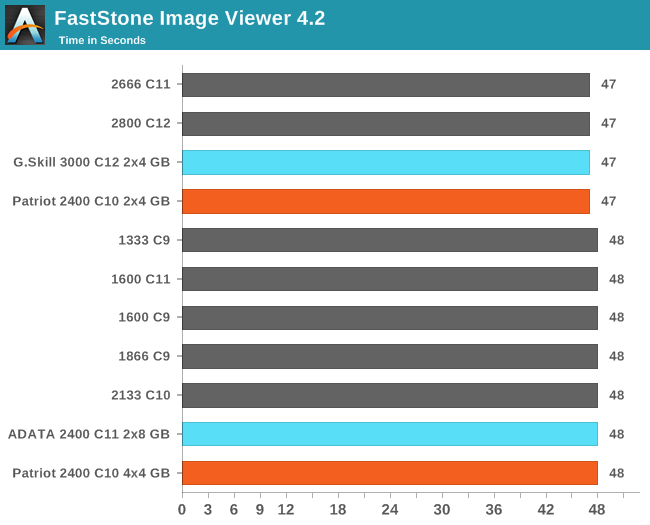
Xilisoft Video Converter 7
With XVC, users can convert any type of normal video to any compatible format for smartphones, tablets and other devices. By default, it uses all available threads on the system, and in the presence of appropriate graphics cards, can utilize CUDA for NVIDIA GPUs as well as AMD WinAPP for AMD GPUs. For this test, we use a set of 33 HD videos, each lasting 30 seconds, and convert them from 1080p to an iPod H.264 video format using just the CPU. The time taken to convert these videos gives us our result in seconds, where lower is better.
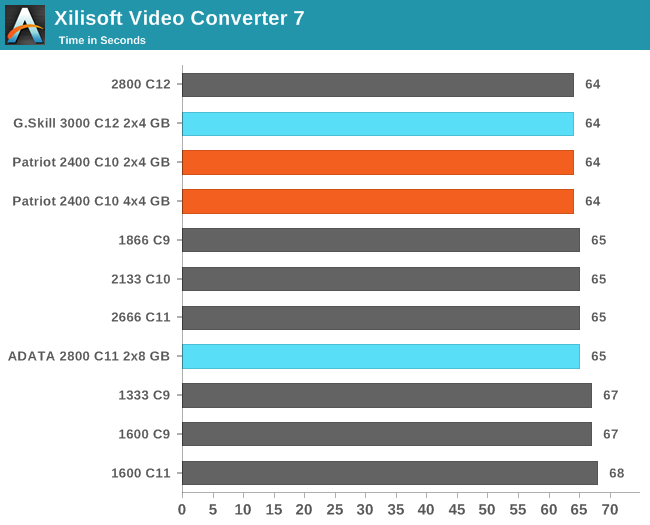
Video Conversion - x264 HD Benchmark
The x264 HD Benchmark uses a common HD encoding tool to process an HD MPEG2 source at 1280x720 at 3963 Kbps. This test represents a standardized result which can be compared across other reviews, and is dependent on both CPU power and memory speed. The benchmark performs a 2-pass encode, and the results shown are the average frame rate of each pass performed four times. Higher is better this time around.
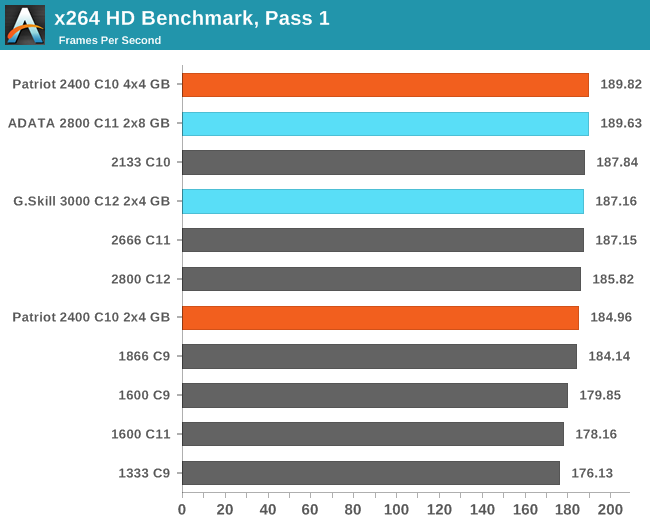
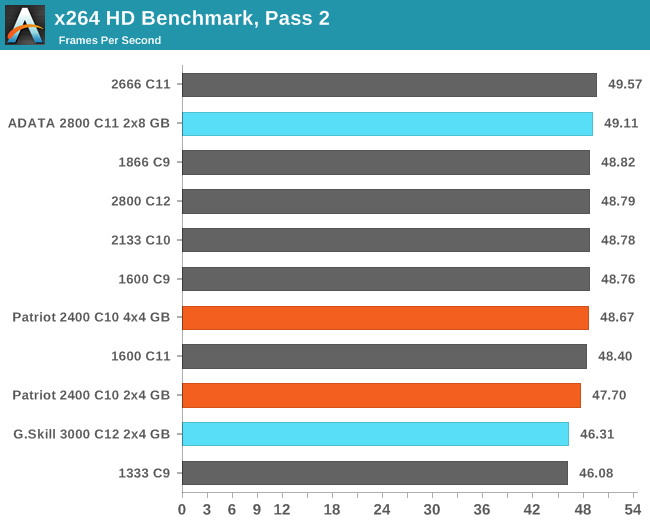
TrueCrypt v7.1a AES
One of Anand’s common CPU benchmarks is TrueCrypt, a tool designed to encrypt data on a hard-drive using a variety of algorithms. We take the program and run the benchmark mode using the fastest AES encryption protocol over a 1GB slice, calculating the speed in GB/s. Higher is better.
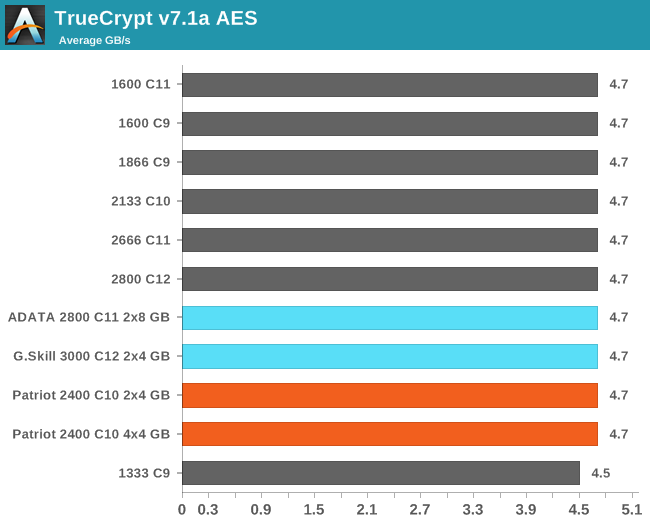










48 Comments
View All Comments
mfenn - Tuesday, November 19, 2013 - link
Expanding upon this point: the data in Anandtech articles is always top notch, but it is becoming more and more obvious that there are two tiers of reviewers when it comes to delivering insight. Anand, Brian, Ryan, and Jarred write good conclusions based on their data and don't care about any blowback from the manufacturers. Dustin and Ian seem beholden to the manufacturer's PR departments and just parrot whatever talking points they're given. It's really disappointing.Gen-An - Tuesday, November 19, 2013 - link
And who exactly do you think is going to be interested in a kit like this, other than overclockers? The review fit the product and the target audience. It's not for general users, never will be, and doesn't need to be reviewed as if it were.Gen-An - Monday, November 18, 2013 - link
Patriot has changed the ICs on this kit without changing the SKU. I have two of the 2x4GB kits that only have 8 chips on a single side of the PCB and none on the other, and use Hynix H5TQ4G83MFR 4Gbit ICs (the same ones that are on those DDR3-3000+ kits) and clock accordingly. One kit I bought but took back was like these in the review, double-sided sticks with 16 chips per stick (8 per side) and using a relatively new IC, Hynix H5TQ2G83DFR, which can't clock as high as H5TQ2G83CFR unfortunately.IanCutress - Monday, November 18, 2013 - link
With the demand for MFR seemingly strong, and other companies other than Patriot going after 2400MHz and up, I guess going to CFR was more a financial choice.Companies seem rather reluctant to tell me which ICs they use, and popping a heatspreader off is no mean feat nowadays, with accidents happening regularly: http://forum.hwbot.org/showpost.php?p=207472&p...
That's compounded by the fact that sometimes the IC # is removed and replaced with the company name over and over. Any suggestions?
Gen-An - Tuesday, November 19, 2013 - link
CFR would have been preferable to DFR, which as you review and this one show, doesn't like going higher than 2600: http://www.techstation.it/articoli/patriot-viper-i...chekk42 - Monday, November 18, 2013 - link
Ian, whatever happened to low latencies? I'm currently running a 1600MHz CL7 kit which I bought 2+ years ago, but I only ever see CL9 (and up) kits in reviews or for sale these days.joos2000 - Monday, November 18, 2013 - link
Lower latencies doesn't yield the same performance returns as upping the clock frequencies, that's why.http://www.anandtech.com/show/7364/memory-scaling-...
ShieTar - Tuesday, November 19, 2013 - link
The reason is that defining latency as a multiple of clocks is rather silly with a large range of clock speeds available concurrently. What your CL7 means is that you have a latency of 4.38 ns (7/1600MHz). The fastest latencies in other clockings available are:1066 CL7 => 6.56 ns
1333 CL7 => 5.25 ns
1600 CL6 => 3.75 ns (But only on 2GB kits)
1866 CL8 => 4.29 ns
2133 CL9 => 4.22 ns
2400 CL9 => 3.75 ns
2666 CL10 => 3.75 ns
2800 CL11 => 3.93 ns
3000 CL11 => 3.67 ns
So as a matter of fact, all kits tested in this review, except for the ADATA ones, have shorter latencies than your own set.
Gigaplex - Tuesday, November 19, 2013 - link
You missed the part where they asked for low latency 1600 and you quoted a 1600 at CL6 without saying where it's from. Like they said, most 1600 kits come at around CL9 which is around 5.63ns. This matters somewhat when Intel CPUs such as the i7 4770K are rated at 1600, any higher and you're running out of spec.ShieTar - Tuesday, November 19, 2013 - link
Not sure how I "missed" that, it doesn't say anything about a 1600 kit at CL9 in the question :" I only ever see CL9 (and up) kits in reviews "
Well, most kits in reviews and announced sales are probably not 1600 at this point in time. In the review above you see 5 kits at 2400+, with only a single 1600 kit thrown in for completeness. So I assumed that the original poster was expecting DDR3 2400 to also come with CL7. Sorry if that assumption was incorrect.
The quoted CL6 kits are "OCZ Reaper HPC Edition" (OCZ3RPR1600C6LV4GK) and "Super Talent Chrome Series" (WB160UX6G6). I think both are actually discontinued, because you can buy a 2400 CL9 set and just run it at 1600 CL6. As shown above, you could even buy a 2400 CL10 set and get a little lucky and still run it at 1600 CL6 (same latency as the tested 1866 CL7)
So sure, DDR3 1600 kits are rarely sold with very low latencies today, that's because low-latency kits are validated and sold at higher frequencies. This does not matter very much, since all kits come with a JEDEC setting to run 1600 initially, and everybody who knows he needs better latencies can lower them by hand to the actual achievable latency. Kits sold as 1600 are really mainly for people looking for cheap memory. Which is fine, as most reviews show little to no relevant gain from faster memory for most tasks anyways.